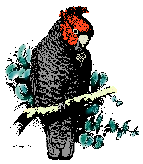Prue and I did our autumn woodland survey this morning in excellent conditions. It was mild and sunny with a variable breeze. The reserve was the greenest it has been for a long time, with all dams full’,
and pools in some of the creeks. There were quite a few wildflowers out, including Variable/Vanilla Glycine, Slender Tick-Trefoil and Sweet Hound’s Tongue amongst a few other things. 51 bird species were recorded, a good total for autumn, with 41 of these
noted during 10 minute counts.
The big highlight was a Black Falcon that zipped over while we were between sites, not the first for the reserve but a new record for our woodland surveys. The only other raptor was a pale Brown Falcon over
site 5. A couple of overflying Great Cormorants were also a new species for the survey. In contrast to some recent visits there was a good amount of small bird activity, particularly at some of our more heavily wooded sites in the south of the reserve. The
most productive mixed flock was at site 7 which included Grey Fantails (8) , Golden Whistlers (10), many Weebills, Buff-rumped Thornbills and Striated and Spotted Pardalotes, and smaller numbers of species such as Rufous Whistler, White-throated Gerygone,
Yellow-faced, Brown-headed and White-eared Honeyeaters, and a Speckled Warbler. Scarlet Robins were present at 2 sites, and a couple of Yellow-tailed Black-Cockatoos were prominent for the first hour or so. A number of summer visitors were still present in
low numbers – besides the species already mentioned these were Western Gerygone, Noisy Friarbird and Olive-backed Oriole. There was no sign of honeyeater migration.
Other fauna was in short supply, although there is an interesting autumn migration of Caper White butterflies at the moment, and we saw at least 10 of these moving through.
Steve

